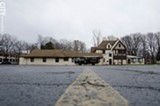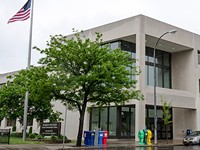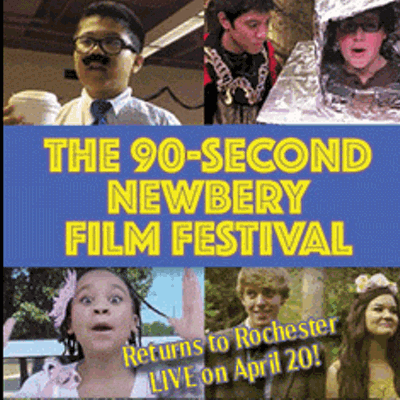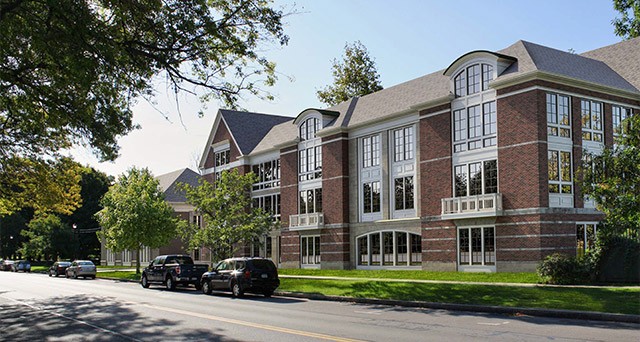
PHOTO COURTESY HANLON ARCHITECTS
Hanlon Architects' design for Morgan Management's proposed use for 933 University Avenue.
[
{
"name": "500x250 Ad",
"insertPoint": "5",
"component": "15667920",
"parentWrapperClass": "",
"requiredCountToDisplay": "1"
}
]
For more on this topic: See Christine Carrie Fien's "Rochester's apartment boom" in this week's news section.
The owners of Craft Company No. 6 have written a letter in opposition to the project.It's not an attractive piece of property right now: a blacktopped parking lot and a mid-1920's stucco house on University Avenue, to which non-descript, architecturally inappropriate extensions have been affixed.
The property is the home of the Monroe Voiture veterans group, which holds its own events there, rents space to 14 other non-profit organizations, including several other veterans groups, and occasionally rents its dining space for outside functions.
Morgan Management – a Rochester firm with numerous apartment complexes in the area – hopes to take over the property, demolish the veterans' building and build a new one for them, and build a large apartment building, three and four stories high, with 102 one- and two-bedroom units.
For the veterans, the Morgan development is a very good deal. In return for their property, they would get a brand new home, and Morgan would take over the maintenance and utility costs for at least the next 99 years.
Morgan must get approval from both the Rochester Preservation Board and the Planning Commission, and that process starts next week. On May 8, Preservation Board members will listen to public comments and then make their own remarks. Board members won't vote, but, says Peter Siegrist, a preservation planner for the City of Rochester, "we urge our members to make pretty solid comments." That will provide "a sense of how the Preservation Board feels," Siegrist says.
Those comments will be sent to the Planning Commission, which will meet on May 20, take comments from the public, and vote. If the Planning Commission approves the project, the application will then go back to the Preservation Board for a vote.
Morgan Management has revised its plans several times in response to neighborhood concerns. It has lowered the number of apartments to 102 from the initial 110 and increased the number of parking spaces to 164, from 139. And it has dramatically changed the exterior. Once an undistinguished structure resembling something in a suburban office park, it now looks like a building on a college campus, with brick on the University Avenue facade and brick and hardy plank on the sides and rear.
There would be 62 one-bedroom and 40 two-bedroom units, 132 underground parking spaces, and 32 above ground spaces, the latter reserved for the Monroe Voiture. Rents for the apartments would be $1100 to $1500, and Morgan vice president Kevin Morgan says the company anticipates that tenants would be young professionals and empty-nesters.
To many public officials, new residential development is attractive, particularly in the City of Rochester, which has been losing population. The project would put tax-exempt property back on the city's tax rolls. And unless all of the residents moved there from nearby, it would put more people in the neighborhood, adding to life on the street in that area – and, presumably, providing customers for nearby restaurants and other businesses.
With those advantages, the proposal might be expected to breeze through the approval process. But the Morgan project is in the East Avenue Preservation District, where demolition, new construction, and even minor exterior changes to a property are strictly regulated.
The Preservation Board will consider whether the Morgan proposal is appropriate for the site and for the preservation district. The Planning Commission will consider land-use issues such as density, parking, and traffic.
Both groups should deny the proposal. It is inappropriate for the preservation district. It's too big for the site. It requires the demolition of an existing house. It dramatically changes the streetscape and the view from the neighboring George Eastman House, which is a national historic landmark.
And it is bad city planning, adding density to an area of the city that doesn't need more. (Disclosure: My husband and I own a two-flat rental unit a few blocks from the Monroe Voiture property.)
Some neighbors are delighted with the plan. But some are not. Among them: the Neighborhood of the Arts Neighborhood Association, in which the Monroe Voiture property lies. Last week, the association issued a statement opposing the development "because the size and the scale of the project is incongruent with property in the East Avenue Preservation District." The stand was the result of several months of studying the Morgan proposal, neighborhood meetings, and a survey of neighborhood residents, businesses, visitors, and others.
Ninety-five people responded to the survey, 59 of them residents, 20 of them neighborhood business owners or employees. Asked whether the Morgan proposal fits in "with the style of the neighborhood," 60 said either that it was better suited to another location or that it was "jarring to the senses." Only 19 had a favorable response to that question.
(The association said it is "open to working with Morgan Management on building in another more appropriate location in the neighborhood.")
The opponents also include the large institutions that flank the Monroe Voiture property: the Greek Orthodox Church of the Annunciation and the George Eastman House. Both object to the size and density of the apartment building, which would cover the vast majority of the Monroe Voiture property and would be relatively near their property line.
Church officials also worry that Morgan tenants would park in the church parking lot, which would be only a few feet away from the apartment building.
Although Morgan would provide 30 more parking spaces for residents than there are apartments, it's likely that many of the two-bedroom apartments would have at least two occupants – and two cars. The same may be true of some of the one-bedroom apartments. And certainly there would be times when the tenants would have guests with cars.
Motorists already use the church driveway and parking lot as an easy route between East Avenue and University, says Amiel Mokhiber Jr., vice president of the church's board of directors, and Morgan tenants and guests would find the lot a convenient parking spot.
Morgan vice president Kevin Morgan says the company doesn't anticipate parking problems. Even some of the two-bedroom units would have only one tenant, he predicts. And while he says he does anticipate that some tenants would park on the street, he says he doesn't think they would use the church parking lot.
"We would make sure to let our residents know on signing a lease that we're not responsible for where they park if they don't park on our property," Morgan said in a recent interview. If they park in the church lot, "they might get towed," he said. "And I think if that happened once, it wouldn't happen again."
But the church would be responsible for policing its lot, and Mokhiber says the church doesn't want to have to do that. Nor does it want to have to put up a gate, forcing church members to have to use access cards to get into their own parking lot.
The Eastman House concerns initially centered on its own future needs: it wanted expansion room for its collections, exhibits, and research. In 2011, GEH, supported by the Monroe Voiture, successfully applied for a Planned Development District that included both properties, as well as that of the Hutchison House, just to the east of the Eastman House on East Avenue.
"The explicit purpose," says GEH director Bruce Barnes, "was to promote the purposes of the George Eastman House and the Monroe Voiture, and it allowed a wide range of non-residential uses, including a restaurant."
The district designation also permitted the development of new multi-family residences. That would permit the Eastman House, a major, national photographic archives and research institution, to build classrooms and a small dormitory if its leaders decided they needed to.
Earlier this year, Barnes was listing the museum's expansion needs as one of the reasons it opposed the Morgan development. But he had just become the museum's new director, and in an interview in late March, he said his view had "changed dramatically."
The museum hired Bergmann Associates to create a new design for its plans for the Monroe Voiture property. It includes a community garden, a sculpture area, a new parking lot for the Eastman House (augmenting the existing one off of East Avenue), and a walkway from the new parking lot to the museum. The changes would "better connect Eastman House with the revitalized Neighborhood of the Arts," Barnes says in a statement in the museum's "Films & Events" publication.
The plan keeps the Monroe Voiture house, and Barnes said last week that the Eastman House would be willing to renovate it and maintain it for the veterans for at least 20 years. And it would be willing to "explore other alternatives, including adapting the first floor of the Hutchison House to be suitable veteran's club facilities."
"We do need more room," he said, but new construction would likely take place somewhere else in Rochester. "We already have a substantial amount of storage" in the nearby Gleason Works building. The museum could move some of its archives, library, and conservation space to another location, Barnes said, opening up space in the existing museum building for exhibitions.
"I don't think – I'm not saying it's impossible – but I don't think we would put it next door," Barnes said.
Barnes said he doesn't rule out classroom space or another "low-impact" construction next door sometime in the future, "but near term," he said, the museum wants to preserve its surroundings.
The Eastman House is facing a problem that is a bit of its own creation. When it first asked the city to rezone its property and that of the Hutchison House and the Monroe Voiture as a Planned Development District, the museum and the veterans reached an agreement that provided for the museum's expansion in return for the museum maintaining the veterans' building – or building them a new one. (There is disagreement now about the specifics of that early agreement.)
For some reason, the museum gave the Monroe Voiture a document later that changed the terms of that agreement, infuriating the veterans. Barnes agrees that the museum dropped the ball on the issue.
Unquestionably, Barnes said in late March, "we didn't handle it well," and he has reached out to the veterans to try to smooth things over. If the Morgan plan doesn't go through, he said, "George Eastman House would still like to enter into an agreement" with the veterans.
But it will have to find a way to smooth things over. Clearly, the veterans find a new building and 99 years of free rent and free maintenance more attractive than a promise of renovations to their existing space and 20 years of free occupancy there.
The current building has "about three times the amount of square footage we need," Monroe Voiture member and club manager Rene Vanmulem says. Some critics of the development proposal worry that because the Monroe Voiture members are aging, their future use of the building is uncertain. But Vanmulem says that after the development issue is settled, "we're going to go after new members in an aggressive way."
And he says that the other activity in the building – space for other non-profits, the events they hold – "justifies the existence of our building beyond our 100 members."
Given the way the Eastman House changed the terms of its initial agreement, Vanmulem said he wasn't sure how the two could have an "amicable" relationship in the future.
And Vanmulem questions whether the Eastman House will have the resources to carry out its plan for the Monroe Voiture property. "You can come up with all the highfalutin ideas you want," he said, "but if you haven't got the money to back it up...."
The Greek Orthodox Church of the Annunciation wants to be able to ease that conflict. "The church would be willing to act as peacemakers," says Amiel Mokhiber. "And we're willing to have a joint venture with the Eastman House to renovate the Monroe Voiture building."
But the church is as opposed to the Morgan development as is the Eastman House. "We believe Bob Morgan is a good person and a good developer," said Mokhiber. "The project may be a good project. But it's just in the wrong place."
We'll get a sense of the prospects for the Morgan plan on May 8, when Preservation Board members make public comments about the development. There is concern that Preservation Board members will look only at the Morgan building's design, and whether it, considered by itself, is appropriate for that site and for the preservation district.
The substantial changes that Morgan made to the building's design seem to have swayed some area residents and some preservationists. But the Preservation Board and the Planning Commission should consider much more than design.
Its presence in the East Avenue Preservation District – the city's first such district – should put the property under extraordinary scrutiny. For Morgan to build its apartments, it will have to tear down the building that houses the Monroe Voiture. The Preservation Board must approve not only the proposed new Morgan structure but also the demolition that will make it possible.
Only three buildings of any size have been demolished in the East Avenue Preservation District since 1969, when the district was formed. Prior to the establishment of the district, some significant houses on East Avenue were demolished, replaced by apartment buildings whose design was inappropriate to their surroundings, dramatically changing the character of part of that important street. The preservation district legislation halted that development.
The Monroe Voiture's stucco house is not of landmark quality itself, but it is a good house, a step or two down from the grander mansions that lined East Avenue at the time. It was built as the home of the daughter of George D.B. Bonbright and his wife, a prominent Rochester family. And it is typical of some of the houses built just off East Avenue in that period.
Demolishing it would set a precedent. The East Avenue Preservation District contains many ordinary old houses – much more "ordinary" than the Monroe Voiture house. Permit the destruction of one, and the Preservation Board makes it hard to prevent the destruction of another, and another, and another... eating away at the fabric of the neighborhood.
That was the justification for making the area a preservation district in the first place – and the justification for the district's boundaries being set at University and Park Avenues, not just along East Avenue.
The focus of a preservation district is not to preserve "landmarks," the most historically and architecturally significant buildings in a city. Preservation districts are designed to protect the character of a larger area, all of the buildings, the open space, the streetscape, the ambiance, the feeling of a historically important neighborhood.
Any new development – any exterior change to a property – must be appropriate to its surroundings. And that includes not only the design of the building but its size, its mass.
In addition to concerns related to the preservation district, public officials must consider the impact that this large, dense development would have on that area of the city, which itself is predominantly a densely developed neighborhood.
One is the loss of green space. Morgan's apartment building and parking lot would leave very little lawn left on property. Although stretches of East Avenue are lined with large homes and relatively large yards, Park and University Avenues and their adjacent streets are densely built.
The neighborhood is also home to three significant, low-density museum campuses: those of the Museum and Science Center, the Memorial Art Gallery, and the George Eastman House. And in an urban neighborhood, with small city yards, the museums' open space not only has visual and passive-recreation appeal but also contributes positively to the environment. Rather than take away green space, as the Morgan plan does, the Eastman House design for the Monroe Voiture property would add to it.
And while Eastman House director Bruce Barnes agrees that the museum may want to build its own facilities on the Monroe Voiture property sometime in the future, that development would be small, he says, set back from University, and no taller than two stories. And if the Eastman House ever wanted to build on the Monroe Voiture property, it would have to go through the same scrutiny that Morgan Management is facing.
There's also the question of the future of the University Avenue-East Avenue-Park Avenue area. What kind of neighborhood should it be? What do the people who live there want?
The Morgan development would add density to an already dense area. And its density has grown because of apartment developments, often in single and two-family homes that were once owner-occupied but are now rental units. This has created both traffic problems and parking problems. And they're compounded by the age of the neighborhood's housing stock. Built at a time when people were much less dependent on cars, many of the houses have nowhere near the parking space needed for the multiple tenants, each with their own car, that now live in them.
The neighborhood, with its art galleries, restaurants, and unique retail stores, has become an attractive place for apartment dwellers, particularly young adults. And their presence has attracted more apartment dwellers – and more developers interested in owning apartments in that neighborhood.
Apartment development is already under way at the old Genesee Hospital site on Alexander Street, just off Park Avenue; at the Culver Road Armory site a few blocks south of Park Avenue; and in individual large houses in the area.
City Councilmember Elaine Spaull, whose district includes the neighborhood, says she hears frequently from people interested in investing in the neighborhood and knows of several lots and buildings being eyed for apartment developments.
With the growth in investor-owner apartments, says city preservation planner Peter Siegrist, that section of the city has "fewer and fewer resident owners." Sometimes the needs and wishes of investor owners and resident owners coincide. But sometimes they do not, and that can change the character of the neighborhood.
At what point does the density become too much? Has this part of the city's southeast area reached its apartment saturation point? Is it time to cap the expansion of apartments in that neighborhood, letting them spread to other areas?
City officials should also consider Morgan's proposal in the context of the goals for the city as a whole. While this project isn't appropriate for the East Avenue Preservation District, it could be a real boon to other areas. It could, for instance, add significantly to the critical mass building downtown.
One important voice has not yet been heard on this issue: that of the Landmark Society of Western New York, which historically has been devoted not only to the preservation of significant individual properties but also to fostering the health and preservation of older neighborhoods. Its research and support have been key in the creation and protection of the city's eight preservation districts.
The organization isn't devoted to preservation at any price; its leaders have been careful to pick their battles, recognizing, for instance, that cost can make a preservation proposal unrealistic. And in some cases, the organization has declined to oppose development, angering some preservationists.
So far, the Landmark Society has not taken a stand on the Morgan proposal. In an e-mail last week, executive director Wayne Goodman said that the Landmark Society is "reviewing all materials."
"We want to make sure that any new construction is done in a manner consistent with the guidelines" of the Preservation Board, Goodman said.
"We do not, as a general rule, rule out new construction as a legitimate form of investment in our historic districts," he said. "But that new construction must be compatible with its surroundings...."
And, he said, the Landmark Society is also studying the existing building housing the Monroe Voiture. "There are many things to consider when a demolition is proposed in a historic district," Goodman said.
Indeed there are. But there are also many things to consider when a new development is proposed for a city neighborhood, whether demolition is involved or not. Additional tax base and the architectural design of individual projects are only two of them.
It is encouraging that Morgan and other developers are willing to invest in the city. But the city has other properties that could be developed. A healthy city needs to house a variety of uses: residential, commercial, open space, institutional. When the city approved the Planned Development District for the Eastman House-Hutchinson House-Monroe Voiture properties, the purpose was to serve the needs of the museum and the veterans. The Morgan development serves the veterans' needs, unquestionably. But it doesn't serve the museum's.
This won't be an easy decision for the Preservation Board and the Planning Commission. The possibility of more tax revenue for the city is attractive. And I understand the concern of the Monroe Voiture's Rene Vanmulem, who told me that he worries that some critics of the Morgan plan would oppose anything. For Morgan Management, and for the Monroe Voiture, the best outcome is for the Preservation Board and the Planning Commission to vote "yes" on Morgan's proposal.
But for the neighborhood, the Eastman House, the Greek Orthodox Church of the Annunciation – and for the city – the best outcome is a "no" vote.
People heavily invested in the neighborhood – residents, the church, the museum – oppose the project. Neighborhood opinion shouldn't be the sole determinant when the two boards vote on the Morgan proposal. But neighborhood opinion has to be considered in any development proposal. And in this case, that opinion has to count for a lot.
I thought about this project recently as I read a Wall Street Journal review of an exhibit focused on the works of the late architect Louis Kahn (whose First Unitarian Church graces Winton Road a little less than two miles from the Monroe Voiture property).
"Kahn saw the planning of a city much like the planning of a house, with areas of the city defined like rooms with specific uses," said writer Colin Amery. "City housing, he thought, should always be the product of the wishes of the neighborhood."
Residents of the neighborhood fought hard for the preservation district that contains the Monroe Voiture property. They fought hard for the restrictions that the preservation legislation provides, because they were convinced that those restrictions would improve not only their neighborhood but the city as a whole.
They were right then. And the Preservation Board and Planning Commission need to stand with them now.
The Morgan proposal is inappropriate for the preservation district, is too big for the site, and is bad city planning.
At what point does the density become too much? Has this part of the city's southeast reached its apartment saturation point?
It is encouraging that Morgan is willing to invest in the city. But the city has other properties that could be developed.
Speaking of...
-
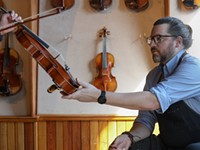
Sought-after sounds at Payton Violins
May 5, 2023 -

Photographer Adam Eaton spotlights beauty
May 18, 2022 -

Calendar preview: Look, listen, dance
Nov 19, 2020 - More »
Latest in Urban Journal
More by Mary Anna Towler
-
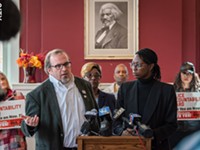
Police reform: advocates on what should come next
Oct 22, 2019 -

Court clears the way for Police Accountability referendum
Oct 17, 2019 -

Dade outlines initial actions on district deficit
Oct 9, 2019 - More »
